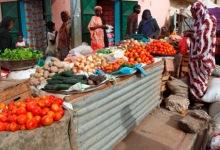
Typical street scene in Santa Ana, El Salvador. (Photo: iStock)
IMF Survey : Mideast Makes Progress on Subsidy Reform
July 10, 2014
- New IMF paper highlights progress in subsidy reform in the MENA region
- Vested interests and other political factors pose challenges to reform
- Measures to protect poor, strong communication are essential to success
A new IMF paper shows how subsidy reform has recently gained momentum in the Middle East and North Africa and outlines the elements of successful subsidy reform.

Vegetable market in Mauritania, a country that has begun putting in place gradual subsidy reform coupled with measures to protect the poor (photo: Corbis)
Middle East and North Africa
In a study, an IMF team led by Carlo Sdralevich and comprising Randa Sab, Younes Zouhar, and Giorgia Albertin looks at recent episodes of subsidy reform in the Middle East and North Africa and the challenges ahead. In the following interview, the authors discuss the experience of countries from the region and beyond in reforming subsidies.
IMF Survey: Can you tell us what the paper is about?
Sdralevich: The IMF has been contributing to the debate on subsidy reform with a book last year that looked at subsidies from a global point of view. This year, staff of the IMF’s Middle East and Central Asia Department focused on the MENA region—where the issue is particularly acute—with a paper that aims at helping countries in the region tackle subsidies. To do so, we review the recent experience of subsidy reform in several countries in the region and lay out forward-looking recommendations based both on these cases and an empirical analysis of 25 reform episodes worldwide.
IMF Survey: In your view, what are the disadvantages of energy subsidies?
Zouhar: The stated objective of subsidies is to make certain products such as fuels or food affordable to the population, especially the most vulnerable. However, this form of social protection is, in fact, biased against the poor who end up receiving only a small fraction of the subsidy benefits. In countries like Egypt, Iran, Jordan, and Lebanon, the poorest 20 percent receives between only 1 and 8 percent of the total spending on gasoline subsidies, while the richest 20 percent receives between 40 and 86 percent. For this reason, generalized subsidies do not necessarily lead to improvements in social indicators.
Albertin: Subsidies are also a major impediment to growth, because they crowd out public spending that can boost growth, including on infrastructure, education, and health. Cheap energy can also lead to the overconsumption of energy, which aggravates environmental problems, such as pollution and climate change. Finally, subsidies encourage greater consumption and, in oil exporters, greater resource extraction and depletion——leaving fewer resources for future generations.
IMF Survey: Why is it so challenging to reform subsidies in the Middle East and North Africa region?
Sab: Compared to other regions, subsidies are very pervasive and costly in MENA. The region’s energy subsidies alone amounted to about $237 billion in 2011, around half of the total subsidies in the world and about 8½ percent of the region’s GDP. Food subsidies are also very common, even though they are less costly, at less than one percent of regional GDP. In fact, subsidies play a special role in the region because they replace almost inexistent social safety nets. In oil-exporting countries, low energy prices are also seen as way to distribute natural wealth to the citizens, and so are considered a right of citizenship and a key element of legitimacy, which can even substitute for political participation.
Albertin: In MENA, political economy factors also make reforming energy subsidies especially challenging. In a number of countries, reform attempts have been reversed because of vested interests. Resistance to reform also reflects a lack of confidence by the population that governments will use the savings from subsidy reform wisely, and that’s why it is so important to leverage strong communication and transparency. In Iran, for instance, subsidy reform was preceded by extensive consultation with stakeholders and an effective public relations campaign.
IMF Survey: We are witnessing a wave of subsidy reform in the region. Why are countries reforming now?
Sab: The two main drivers for reform have been the high level of oil prices after the global financial crisis, and the increased use of subsidies to meet social demand since 2011. The resulting fiscal unsustainability of subsidies has triggered reform in oil-importing countries, particularly in Jordan, Mauritania, Morocco, and Tunisia, which have focused on gradually raising fuel prices and electricity tariffs and adopting automatic price mechanisms to depoliticize the price setting. These countries also took care to couple subsidy reform with mitigating measures—for instance, cash transfer programs, among others—to protect the poor.
IMF Survey: What are the paper’s main lessons for MENA countries?
Sdralevich: This is a good summary question. Our analysis of the experience in reforming subsidies underlines the importance of a sound preparation of the reform, and strong ownership by a committed government that invests in an effective communication campaign.
Zouhar: A final lesson is on the introduction of alternative social protection tools, such as cash transfers. International experience shows that reforms are more successful when governments immediately introduce measures to mitigate the impact of the price increase on the poor. So addressing, from the outset, the social aspect of reform also helps make it more successful.


